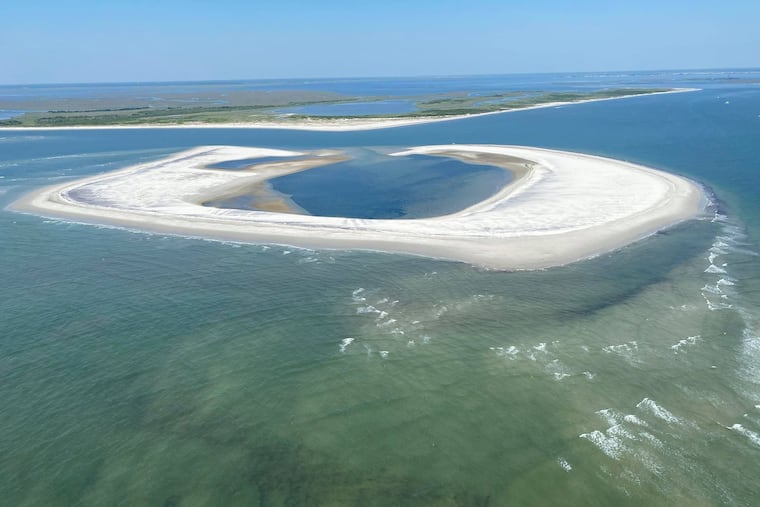New Jersey once again blocks access to newly emerged ‘Horseshoe Island’ off the Shore
Recreational use of the 100-acre island by boaters is restricted until Sept. 30 to protect birds that are nesting there.

New Jersey has once again closed off what it has dubbed Horseshoe Island, a curl of sand roughly the shape of its name off Brigantine that officials say provides thousands of birds with an undisturbed habitat but has been used by boaters in the past.
The island, formed from a sandbar, or shoal, is about 100 acres, complete with lagoon.
The state Department of Environmental Protection this week reminded the public that it was restricting access to the island through Sept. 30, saying it has become “one of the most critically important areas for birds in the state of New Jersey, including many species that are endangered, threatened, or are species of special concern.”
Officials moved to close it for the first time last year just before Memorial Day weekend, angering boaters who had flocked to the island to sunbathe, swim, and picnic.
» READ MORE: A new island emerges at the Jersey Shore, and boaters are angry it’s been closed to protect birds
The yearly closure is the result of a state Tideland Resource Council vote in 2022 to assign management rights of Horseshoe Island to NJDEP Fish and Wildlife, including restricting public use annually from March 1 to Sept. 30 for five years.
“This seasonal restriction on Horseshoe Island provides thousands of birds with an unparalleled opportunity to utilize a disturbance-free inlet island for nesting, migrating, and roosting,” the DEP said in a statement. “In this instance, providing undisturbed habitat has paid big dividends for avian species including red knot, piping plover, black skimmer, least tern, common tern, and American oystercatchers, which the New Jersey Wildlife Action Plan identifies as focal species of greatest conservation need.”
The island is about 1,200 feet offshore, just south of Little Egg Inlet off what’s known as Little Beach Island near Brigantine. So far, it’s survived years of storms, unlike some sandbars that disappear or reduce in size. Sandbars are nothing new at the Jersey Shore — coming and going with the tides, and ever shifting their shapes.
But Horseshoe Island is different, officials have said, because of its size, location near protected areas, and apparent staying power. Though it seems counterintuitive, the wide open island with little vegetation provides prime habitat where birds can lay eggs in the sand that serves as camouflage.
The island formed in an area that’s part of both Little Egg and Brigantine Inlets in Atlantic County. The area includes more than 100 miles of inlets.
Little Egg Inlet is within the Edwin B. Forsythe National Wildlife Refuge, managed by the U.S. Fish and Wildlife Service. It’s also adjacent to other state and federal wildlife management areas or preserves. The region harbors Endangered Species Act-listed bird species native to New Jersey including piping plover, red knot, black rail, and roseate tern, as well as numerous state endangered and threatened species including black skimmer and least tern.
Biologists first confirmed in May 2021 that shorebirds and waterbirds were using Horseshoe Island for breeding.
However, boaters have complained that the island is really nothing more than a sandbar that’s been around in one shape or another since at least 2013.
They objected to its closure, calling that decision excessive, given that the area is already surrounded by tens of thousands of off-limits acres. Boaters say they cleaned up after themselves and respected the areas with posted signs around bird habitat areas.
On weekends before the ban, 20 to 30 watercraft might be anchored on the island. On holidays, there were more.